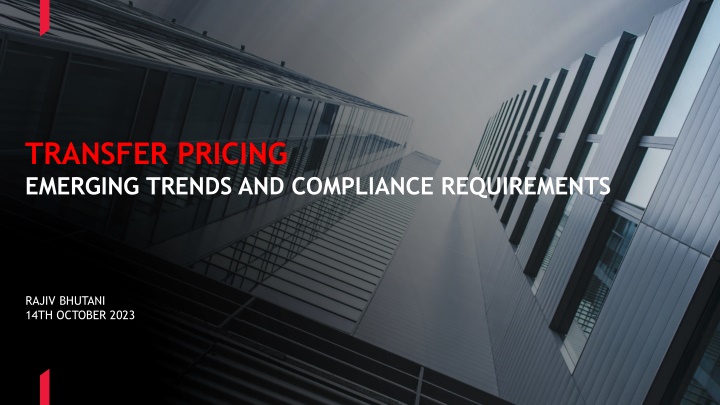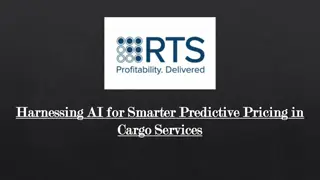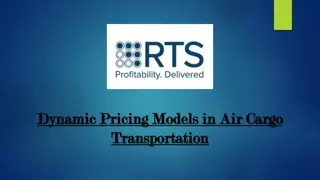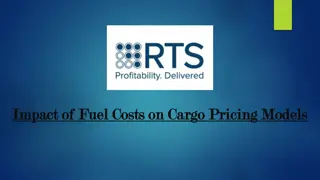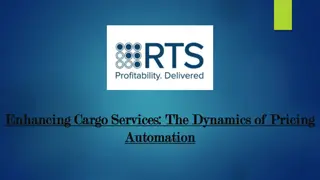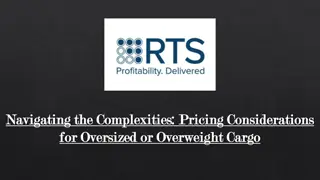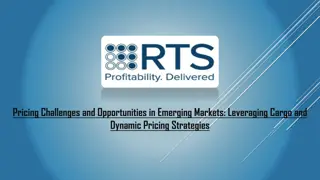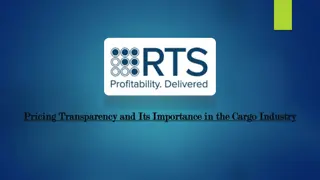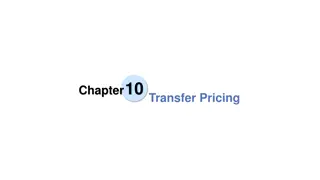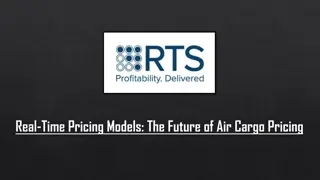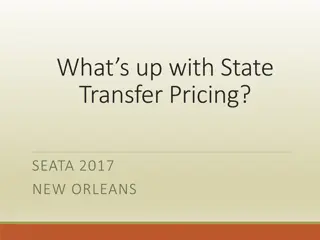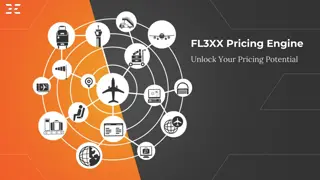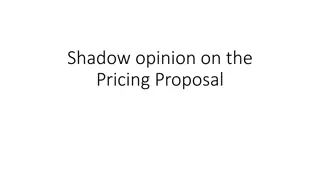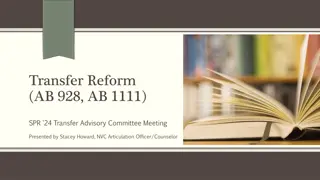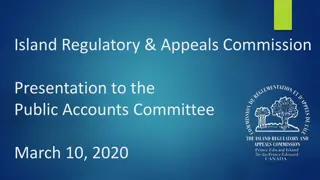Transfer Pricing Compliance and Documentation: Emerging Trends and Requirements
Explore the evolving landscape of transfer pricing compliance and documentation, delving into key aspects such as certification, master files, emerging issues, Indian APA program, and MAP regime. Learn about the critical documentation requirements related to entity transactions, business overviews, economic analyses, and more. Dive into the comprehensive process of gathering background information, functional and financial analyses, and industry insights. Get insights into key considerations in the documentation process and methods for computing arm's length prices. Stay informed and compliant in the ever-changing transfer pricing environment.
Download Presentation

Please find below an Image/Link to download the presentation.
The content on the website is provided AS IS for your information and personal use only. It may not be sold, licensed, or shared on other websites without obtaining consent from the author.If you encounter any issues during the download, it is possible that the publisher has removed the file from their server.
You are allowed to download the files provided on this website for personal or commercial use, subject to the condition that they are used lawfully. All files are the property of their respective owners.
The content on the website is provided AS IS for your information and personal use only. It may not be sold, licensed, or shared on other websites without obtaining consent from the author.
E N D
Presentation Transcript
TRANSFER PRICING EMERGING TRENDS AND COMPLIANCE REQUIREMENTS RAJIV BHUTANI 14TH OCTOBER 2023
TABLE OF CONTENTS 01. Transfer Pricing compliance - Documentation 02. Transfer Pricing compliance - Certification 03. Transfer Pricing compliance Master File & CbCR 04. Emerging issues in Transfer Pricing 05. Indian APA Program 06. Indian MAP Regime 2
TRANSFER PRICING COMPLIANCE DOCUMENTATION REQUIREMENTS Entity related Price related Transaction related Business overview of the Group Transaction terms Inter-company Agreements Profile of Associated Enterprises Functional analysis Invoices Business overview of the Indian entity Economic analysis Pricing related correspondence Forecasts/ budgets Need-benefit documentation Industry overview Back-up workings Third party supporting documents Contemporaneous TP Documentation Due on October 31st Applicable if value of international transactions exceed INR 1 Crore. TP Certificate Due on October 31st Applicable with even INR 1 international transaction. 4
TRANSFER PRICING COMPLIANCE PROCESS Gathering Background Information 1 TP Certification Functional Analysis 6 2 5 3 Financial Analysis Industry Analysis 4 Economic Analysis 5
TRANSFER PRICING DOCUMENTATION KEY CONSIDERATIONS STAGE 2 STAGE 1 STAGE 3 STAGE 4 STAGE 5 Information gathering Functional Analysis Issuance of TP Documentat ion Comparable data gathering Pre-Project Planning Analysis Preparation of Project Plan Functional questionnaires FAR discussions with management Agreement reviews Characterisation of entities Assessment of Internal comparable data Search strategy for external comparable analysis Assessing databases Comparison with Company s data Determination of arm s length price Consultation with management Finalization of TP Documentation 6
TRANSFER PRICING DOCUMENTATION METHODS FOR COMPUTING ARM S LENGTH PRICE Comparability Requirements Approach Practical Applicability Comparable Uncontrolled Price (CUP) Method Very high Prices are compared Low Resale Price Method (RPM) High Gross margins are compared Low Cost Plus Method (CPM) High Gross margins are compared Low Profit Split Method (PSM) Medium to High Profit margins are compared Low Transactional Net Margin Method (TNMM) Medium Net Profit margin are compared High Other Method Very High Quotations are compared High 7
MOST APPROPRIATE METHOD COMPARABLE UNCONTROLLED PRICE METHOD Most Direct Method and Reliable Method Prices are benchmarked without any reference to the profits Requires strict comparability in products, contractual terms, economic terms, etc Key considerations around Volume or quantity of products, Credit terms, Geographic market, Other terms of contract Strengths: Two-Sided Analysis, Avoids the issue of selecting Tested Party Weakness: Availability of comparable data Internal CUP as well as External CUP 8
MOST APPROPRIATE METHOD RESALE PRICE METHOD Compares the resellers Gross Margin Preferred method for a distributors - buying finished goods from a group company and reselling in the market Comparability is relatively less dependent on product comparability and additional emphasis is on similarity of functions performed & risks assumed Used when reseller does not add substantial value to the goods and does not apply intangible assets to add value Difficult to apply where goods are further processed before resale 9
MOST APPROPRIATE METHOD COST PLUS METHOD Compares and identifies mark-up earned on direct and indirect costs of production incurred with that of comparable independent companies Preferred method in case: Semi-finished goods sold between parties Long term buy and supply arrangements Provision of services Not applied in transaction involves full fledged manufacturer. i.e Supplier is contract/toll manufacturer Comparability is relatively less dependent on strict product comparability and additional emphasis is on similarity of functions performed & risks assumed 10
MOST APPROPRIATE METHOD PROFIT SPLIT METHOD PSM is applied in cases: involving transfer of unique intangibles or multiple transactions that cannot be evaluated separately PSM requires selection and application of appropriate allocation keys for splitting profits amongst the members of the MNE group contributing to generation of combined profits. Strengths of PSM: Offers solutions for integrated operations Helps share profits for unique intangibles contributed Weaknesses of PSM: Difficulty in application selection of allocation keys Reluctance of tax authorities to accept 11
MOST APPROPRIATE METHOD TRANSACTIONAL NET MARGIN METHOD Most frequently used method, due to lack of availability of data for application of other methods Examines net operating profit from transactions as a percentage of a certain base (can use different bases i.e., costs, turnover, etc.) Broad level of product comparability and high level of functional comparability Applicable for most categories of transaction and often used to supplement analysis under other methods Grouping of transaction - Relevant controlled transactions require to be aggregated to test whether the controlled transaction earn a reasonable margin as compared to uncontrolled transaction 12
MOST APPROPRIATE METHOD OTHER METHOD Rule 10AB - any method which takes into account the price which has been charged or paid, or would have been charged or paid, for the same or similar uncontrolled transaction, with or between non- associated enterprises, under similar circumstances, considering all the relevant facts." Implies Quotations rather than actualprices charged or paid can also be used as comparables To maintain proper documentation specifying the rejection reasons for non-application of other five methods and appropriateness of the OtherMethod 13
TRANSFER PRICING ANALYSIS PRACTICAL CONSIDERATIONS Concept of Range, Median, Mean Operating vs. Non- operating nature Profit Level Indicator Tested Party Based upon functional characterisation Varied depending upon nature of transaction More comparables Range is to be seen (35th to 65th Percentile) than 6 Examples operating nature: of Non- Has to be a Least complex entity Should tainted transaction not be a Forex fluctuation gain/ loss If arm s length price outside range; Median needs to be compared Records data should be easily available & financial Examples: Bank charge or interest Net Profit on Cost Operating Gain/ loss on sale of investment Less comparables Mean is to be compared (have a benefit of 3% range on transaction price) than 6 Net Profit on Revenue Operating Extraordinary items Gross Profit on Revenue 14
TRANSFER PRICING CERTIFICATION (FORM NO. 3CEB) REQUIREMENT Clause Clause 10 List of Associated Enterprises Clause 11 Tangible property Clause 12 Intangible property Clause 13 Services Clause 14 Lending/ borrowing of money Clause 15 Corporate guarantee Clause 16 Marketable securities Clause 17 Mutual agreements Clause 18 Business restructuring Clause 19 Any other transaction Clause 20 Deemed international transaction Clause 21 List of Domestic related parties Clause 22 Transfer of any goods or services Clause 23 SDT in the nature of any business Transactions related to: To be obtained and filed by every person entering into international transactions (even INR 1) Due date for uploading it with Indian Income Tax Authorities is October 31st Penalties Failure in filing of Form No. 3CEB INR 100,000 Failure to maintain TP documentation or TP Certification or maintenance of incorrect documentation 2% of value if international transactions Concealment of income or furnishing inadequate particulars of income in respect of Arm s length price (ALP) adjustments 100% to 300% of tax sought to be evaded Clause 24 SDT between persons referred to section 115BAB(6) Clause 25 SDT not specifically referred above 16
TRANSFER PRICING CERTIFICATION (FORM NO. 3CEB) KEY CONSIDERATIONS List of associated enterprises with whom the assessee has entered into international transactions Clause 10 (a) Name of the associated enterprise. (b) Nature of the relationship with the associated enterprise as referred to in section 92A(2). (c) Brief description of the business carried on by the associated enterprise. 17
TRANSFER PRICING CERTIFICATION (FORM NO. 3CEB) KEY CONSIDERATIONS Clause 11 Particulars in respect of transactions in tangible property (A) International transaction(s) in respect of purchase/ sale of raw material, consumables or any other supplies for assembling or processing/manufacturing of goods or articles. Name Address Description Quantity Amount Method (B) International transaction(s) in respect of purchase/sale of traded/finished goods. Name Address Description Quantity Amount Method (C) International transaction(s) in respect of purchase, sale, transfer, lease or use of any other tangible property. Name Address Description Quantity Amount Method 18
TRANSFER PRICING CERTIFICATION (FORM NO. 3CEB) KEY CONSIDERATIONS Clause 12 Particulars in respect of transactions in intangible property Few Examples of Transactions: Requirements of Clause Tradename or Brand royalty Name of associated enterprise Technical fee Address of associated enterprise Technology License fee Tax Identification No. of associated enterprise Fee for Designs/ Drawings Description of IP Nature of transaction Amount Method adopted for arm s length price 19
TRANSFER PRICING CERTIFICATION (FORM NO. 3CEB) KEY CONSIDERATIONS Clause 13 Particulars in respect of providing of services Few Examples of Transactions: Requirements of Clause Software development service Name of associated enterprise IT enabled services Address of associated enterprise Marketing support services Tax Identification No. of associated enterprise Back-office support service Description of service Engineering service Amount Technical services Method adopted for arm s length price 20
TRANSFER PRICING CERTIFICATION (FORM NO. 3CEB) KEY CONSIDERATIONS Clause 14 Particulars in respect of lending or borrowing of money Requirements of Clause Name of associated enterprise Address of associated enterprise Tax Identification No. of associated enterprise Nature of financing arrangement Currency Interest rate Amount Method adopted for arm s length price 21
TRANSFER PRICING CERTIFICATION (FORM NO. 3CEB) KEY CONSIDERATIONS Clause 15 Particulars in respect of transactions in the nature of guarantee Requirements of Clause Name of associated enterprise Address of associated enterprise Tax Identification No. of associated enterprise Nature of guarantee arrangement Currency Compensation/ guarantee fee Method adopted for arm s length price 22
TRANSFER PRICING CERTIFICATION (FORM NO. 3CEB) KEY CONSIDERATIONS Particulars in respect of international transactions of purchase or sale of marketable securities, issue and buyback of equity shares, optionally convertible/ partially convertible/ compulsorily convertible debentures/ preference shares Clause 16 Few Examples of Transactions: Requirements of Clause Share capital infusion Name of associated enterprise Investment made in share capital Address of associated enterprise Tax Identification No. of associated enterprise Nature of arrangement Currency Consideration Method adopted for arm s length price 23
TRANSFER PRICING CERTIFICATION (FORM NO. 3CEB) KEY CONSIDERATIONS Clause 17 Particulars in respect of mutual agreement or arrangement Few Examples of Transactions: Requirements of Clause Management cross charge Name of associated enterprise Any allocation of charge from/ to associated enterprise Address of associated enterprise Tax Identification No. of associated enterprise Description of such mutual agreement or arrangement Amount Method adopted for arm s length price 24
TRANSFER PRICING CERTIFICATION (FORM NO. 3CEB) KEY CONSIDERATIONS Particulars in respect of international transactions arising out/ being part of business restructuring or reorganizations Clause 18 Requirements of Clause Name of associated enterprise Address of associated enterprise Tax Identification No. of associated enterprise Nature of transaction Agreement in relation to such business restructuring Terms of business restructuring Method 25
TRANSFER PRICING CERTIFICATION (FORM NO. 3CEB) KEY CONSIDERATIONS Particulars in respect of any other transaction including the transaction having a bearing on the profits, income, losses or assets of the assessee Clause 19 Few Examples of Transactions: Requirements of Clause Reimbursement of expenses Name of associated enterprise Recovery of expenses Address of associated enterprise Pass through costs Tax Identification No. of associated enterprise Description of transaction Amount Method adopted for arm s length price 26
TRANSFER PRICING CERTIFICATION (FORM NO. 3CEB) KEY CONSIDERATIONS Clause 20 Particulars of deemed international transactions Requirements of Clause Name of person other than associated enterprise Address of person other than associated enterprise Tax Identification No. of such other person Description of transaction Amount Method adopted for arm s length price 27
TRANSFER PRICING CERTIFICATION (FORM NO. 3CEB) KEY CONSIDERATIONS Clause 21 to 25 Specified domestic transactions Requirements of Clauses Details of domestic related parties Details regarding specified domestic transaction with any undertaking or unit or enterprise or eligible business of the assessee [as referred to in section 80A (6), 80IA(8) or section 10AA)] Details regarding specified domestic transaction with any associated enterprise which has resulted in more than ordinary profits to an eligible business to which section 80IA (10) or section 10AA applies Details regarding specified domestic transaction between the persons referred to in sub-section (6) of section 115BAB 28
MASTER FILE AND COUNTRY-BY-COUNTRY-REPORT (CBCR) MASTER FILE Group s document a policy level document No financial data required OECD Guidance plus India specific requirements Applicability: Group s revenue exceeds INR 500 Cr; and Taxpayer s related party transaction exceed INR 50 Cr CBCR Group s document with a lot of financial data Focuses on appropriate allocation of substance with the remuneration Applicability: Group s revenue exceeds INR 6,400 Cr Master File (Designation Intimation) Form 3CEAB CbCR Master File (Part A) Form 3CEAA Master File (Part B) Form 3CEAA CbCR (Intimation) Form 3CEAC Form 3CEAD January 31st March 31st October 31st November 30th November 30th 30
TRANSFER PRICING IN INDIA AGGRESSIVE COUNTRY... 32
TRANSFER PRICING IN INDIA AGGRESSIVE COUNTRY India one of the top countries with aggressive transfer pricing disputes - MNCs with related party transactions seen as one of the targets for tax collection - Focus on profit margins location saving embedded in high comparable margins - Subjectivity on comparables selection tax officer tries to select high-profit margin comparables - Functional re-characterization (adding new weapons such as surveys, information from 3rd parties, social media) - Rejection of economic adjustments Triggers - Any pricing model change - Low profitability - Dip in related party revenue - Royalty payments - Subjectivity on comparables - Intra-group charges Domestic litigation route Supreme Court High Court Tax Tribunal First level appeal Field Officer 6 to 8 years 6 to 8 years 33
EMERGING TP ISSUES KEY TRENDS Royalty Management Cross Charges Rationale for paying Royalty gets challenged Royalty rate gets challenges comparables related challenges Claims for being duplicative in nature Important to demonstrate criticality for using brand/ technology/ etc, maintain proper workings Litigative issue - generally prevalent in MNCs Tax Authorities allege siphoning out of money Extremely subjective difficult to demonstrate receipt of services, actual benefits from services Cost allocation strategy Need-Benefit documentation is the key exclusivity, Functional characterisation Comparability challenges Subjectivity around Transfer Pricing Remuneration model gets challenged Proper documentation of functional aspects is extremely critical Remuneration to commensurate with functions and risk profile of Indian entity Choice of comparables has always been a subject matter of discussion Broad comparability acceptable in law Tax Authorities prefer high-profit margin comparables Critical to use right quantitative filtration and qualitative review for comparable selection 34
INDIAN APA PROGRAM KEY FEATURES Advance Pricing Agreement (APA) An agreement between taxpayer and Indian government/ tax authority, in order to determine arm s length price OR specifying the manner in which arm s length is to be determined. Coverage Timelines Types Binding Effect Unilateral: Involves taxpayer and India APA authority APA covers 5 prospective years, starting after filing of APA application also has an option to apply APA result up to past 4 years (roll back years). APA, when agreed and signed, is binding on taxpayer and income tax authorities. Average time taken in the process to get APA: Bilateral: Involves taxpayer, India APA authority, foreign entity, foreign APA authority - Around 2 years in case of Unilateral APA Binding international covered in APA. in respect transactions of - Around 3 years in case of Bilateral or Multilateral APA Multilateral: taxpayer, India APA authority, multiple foreign respective foreign authorities Involves entities, Preparation for APA filing and Pre- filing discussion APA Discussions, Written submissions, Site visit, Position paper review, etc Finalization and APA signing application filing 36
APA ADVANTAGE VALUE OF APA vs NO APA Approach - Aggressive pricing approaches adopted during TP audits - Challenge in explaining functional characterization along with economic analysis - Paucity of time to understand the business and dispose cases - Batch processing approach for common issues standard comparable applications for margins Duration - Yearly audit takes 6-8 years to defend through normal litigation route Compliance - Lack of clear direction during TP audit proceedings - Significant additional information sought at the time of TP audit Without APA Approach - Consultation process and pragmatic approach - Able to devote necessary time - Each case is handled separately and only physical mode to discuss the business and transactions Duration - About 2 years to get certainty for 9 years (with a good possibility of renewal thereafter) Compliance - Clear agreement on the financial and other information to be maintained With APA 37
INDIAN MAP REGIME Alternative mechanism for domestic litigation route Resolution of disputes through intervention of Competent Authorities (CAs) Avoidance of double taxation Suspension of collection of demand Appeal/ tax demand proceedings can be kept in abeyance till MAP conclusion 39
INDIAN MAP REGIME MAP OVER DOMESTIC APPEAL PROCESS Parameters MAP process Domestic appeal process Estimated time of completion Average time period of 2 years 6-10 years Documentation requirement Less burdensome as compared to domestic litigation Detailed and burdensome documentation/ evidence requirements Payment of tax demand Stay of demand can be obtained Periodic tax demands can be raised by the tax authorities Compliance Minimum Extensive Interest and Penalty Interest: same as in typical litigation process Penalty: generally not levied by authorities post MAP Penalty generally levied, however, defendable on TP issues Double taxation Addressed issue of double taxation corresponding relief is allowed Likely to continue Basis of closure Negotiation between two countries CAs. Taxpayer s role is to brief the CA Merit based relief can be expected at Tribunal level once sufficient evidence is produced satisfying the arguments 40
